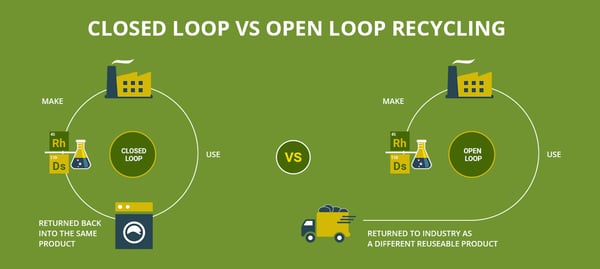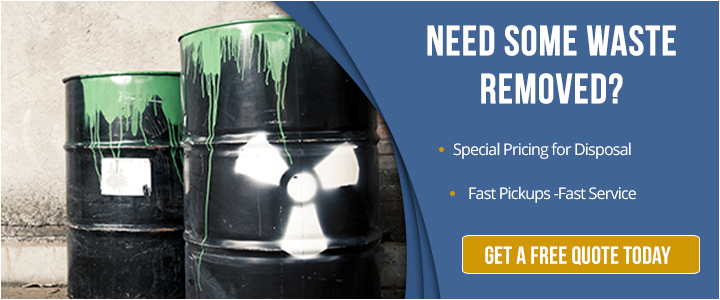Closed loop recycling is a highly sustainable concept thriving across several industries, and as more and more companies look for ways to lessen their environmental footprint, they are turning to this process to keep waste out of landfills.
What is closed loop recycling? Closed loop recycling is defined as a process where waste is collected, recycled and then used again to make the same product it came from. This process is restorative and regenerative by design and aims to always keep materials at their highest utility and value.
This closed loop recycling definition offers ample opportunities for businesses to boost the sustainability of their operations. The top circular economy companies globally have found ways to take the waste they produce and reuse it to gain a competitive advantage.
Particularly in manufacturing, this approach that embraces the circular economy is growing, especially in managing solvent waste.
Below we’ll explore the closed loop recycling definition as well as:
- How closed loop recycling differs from open loop recycling when it comes to managing solvent waste
- How zero waste can be achieved through closed loop recycling
- Why your disposal partner is an important component of managing your waste
Open Loop Recycling Vs. Closed Loop Recycling
Hazardous waste generators that produce solvent waste generally have two main options for their disposal. One is a form of open loop recycling and the other is a form of closed loop recycling. Although both types of recycling are environmentally-friendly, one achieves a higher level of sustainability than the other.

Open Loop Recycling
The first is fuel blending, a form of open loop recycling. Fuel blending typically occurs at a local or regional treatment, storage and disposal facility (TSDF) where solvent waste is mixed with commercial fuels to cement kiln specifications. After blending, this mixture is transported to a cement kiln where it is used as an alternative fuel.
Open loop recycling is a method that delays disposal by converting manufactured goods and spent materials into new raw materials. These materials then can be used for a manufacturing purpose, as a fuel source for a different manufacturing process or waste products.
In other words, materials recycled through open loop systems are used for purposes different from their original purpose.
Closed Loop Recycling
While fuel blending is considered an environmentally-friendly option for solvent-based liquids, solids and sludge since it is a form of recycling, it is not the most sustainable option.
On the other hand, closed loop recycling focuses on natural resource sustainability. This means that material recycling can be done indefinitely without degradation of properties.
This brings us to the second option for disposal, solvent distillation when part of a closed loop recycling system. Solvent distillation separates a liquid or vapor mixture of two or more substances into its component fractions of desired purity through the removal of heat.
The solvent distillation recovery process is based on the fact that the vapor of a boiling mixture is richer in low boil point components. After the vapor cools and condenses, the liquid condensate is ready to be sold back into the industry.
Zero Waste Achieved Through Closed Loop Recycling
Solvent distillation doesn’t have to be a stand-alone solution to your solvent waste. In fact, when part of closed loop recycling, it can be an incredibly sustainable solution.
solvent waste. In fact, when part of closed loop recycling, it can be an incredibly sustainable solution.
Closed loop recycling facilities often have three stages to their recycling processes:
- Waste to energy
- Solvent distillation
- Water treatment
Each of these three stages links together to form a circle. The waste to energy process begins the loop. At the waste to energy plant, organic solids with sufficient BTU are converted to energy in the form of steam. A conveyor feeds waste into the primary stage for thermal destruction, followed by a second thermal treatment.
Inorganic solids, or ash, from the primary stage, are quenched and fall into an ash hopper. Heat is then directed to a steam generator.
The solvent distillation process then begins. A wide variety of solvents are acceptable for use in a solvent distillation unit, from aromatics to alcohols, ketones and esters.
A water treatment process closes the circle. This process extracts usable water from industrial hazardous wastes. Treated water can then be used on-site for industrial needs.
If your company generates solvent waste, this closed loop recycling process ensures that you achieve zero waste. No materials are wasted or discarded, and the properties of the material do not degrade.
How Your Disposal Partner Plays An Important Role
Managing your industrial waste disposal plays an important role in staying compliant as you transition your waste management to include closed loop recycling.
Most industrial solvents are considered hazardous industrial waste and must adhere to cradle to grave requirements. These laws require that all generators be responsible for the proper disposal of their hazardous waste streams from the moment they are created to the moment they are properly and legally disposed of.
This is the primary reason why virtually all waste generators use a reputable disposal company. Hiring a certified company to help you manage this process can help alleviate any issues that might arise once waste leaves your facility.
There’s an added bonus to working with experienced hazardous waste disposal companies. The best disposal companies can help you determine whether your industrial waste can be classified as non-hazardous also can provide substantial cost savings and alleviate any issues with the California Department of Toxic Substances Control.
When looking for a waste disposal company to partner with, credibility, experience and flexibility are important characteristics.
Never be afraid to do a background check on a company you are considering, and inquire about how flexible the company is with any changes in needs you experience over time.
A disposal company that offers a hazardous waste walk-through program can be an important clue in whether a business you are considering is experienced and comprehensive in its services. A walk-through program is consultative and covers areas of focus like:
- Waste manifesting
- Hazardous waste procedures
- Waste storage evaluation
- Emergency readiness
- Hazardous waste evaluation
- Employee training procedures
Experienced waste disposal companies will walk you through the process of ensuring all regulations are being met so that you can rest assured all aspects of sending your solvent waste to closed loop recycling facilities are legal and safe.


Comment